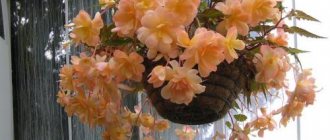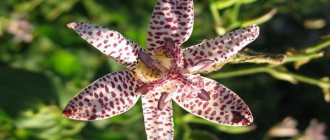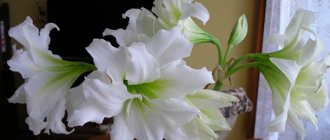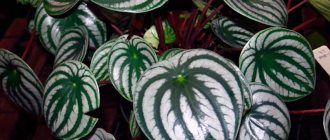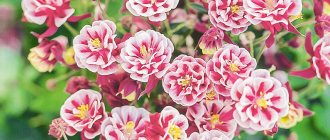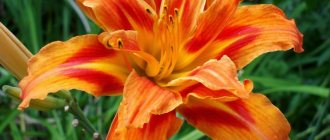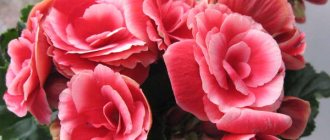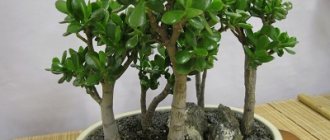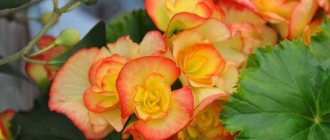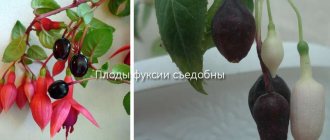Characteristics of the subspecies
A subspecies of tuberous begonias is ampelous, and can also be called cascading or pendula. The latter are often sold in stores as a series of varieties of hanging begonias, with differences in color characteristics.
These are herbaceous plants with a succulent stem, tuberous roots and asymmetrical toothed leaves. The main interest for gardeners is its flowers. Terry varieties of hanging begonias have male and female flowers. The male ones are larger and bloom first, the female ones appear later and are non-double in the structure of the bud. It turns out that one bush can have both double and non-double inflorescences at the same time.
With proper care, the flowering of tuberous begonias is lush, to the point that the foliage is practically invisible because of the flowers. The petals come in different shades of yellow and red, orange, pink, coral and salmon. There are varieties in which the edge of the petal is edged with a different color.
The sizes of flowers vary from small - 2-3 cm in diameter, to giant - 15-20 cm. They are also different in shape: double and regular, similar to roses, peonies, camellias and even daffodils. During the period of active flowering, pendula bushes turn into lush “caps” of bright colors.
Due to the characteristics of hanging varieties, they are used mainly for landscaping terraces and balconies, loggias, shop windows, grown in hanging boxes and flower pots. It grows quite well at home, however, in the warm season it is still preferable to send it to fresh air.
Ampelous begonia: general description
Ampelous begonia is a tuberous perennial plant with asymmetrical leaves and self-flowing stems. The height, depending on the variety, can vary from 20 to 60 cm, the length of the leaves is no more than 20 cm. Belleconia salmon begonia stands out among its relatives with long hanging shoots, their length can reach 1 m. It has an alternative name - drooping begonia.
The vast majority of plant species and varieties have richly colored buds, the diameter of the inflorescence is 5-10 cm.
Note! In the first years after planting, the plant may bloom with unattractive flowers, this is due to the fact that the flowers are female. After a certain time, if all the rules of agricultural technology are observed, men's will soon appear.
The plant loves the hot and humid climate of the tropics and subtropics; in the wild it is most often found in Asia, India, South America and Africa. For the first time in Europe they learned about this plant at the end of the 17th century.
Begonia tuberous ampelous
As a rule, flowering begins in mid-summer and lasts until the first frost, but this is only possible under favorable weather conditions and subject to the rules of agricultural technology. At home, you can contemplate the flowering throughout the year.
Important! The lifespan of each flower is no more than 10 days, long flowering is ensured by the constant blooming of new flowers.
Popular varieties
Garden begonia 'Illumination Apricot'
Some varieties of hanging begonias are combined into series. For example:
- Illumination – plants of this series grow quickly, branch well and bloom luxuriantly. Shoots up to 30 cm hanging. Double flowers with a diameter of 5 to 7 cm. The series is presented in four colors. The most popular variety in the series can be safely called Illumination apricot.
- Sensation is a dwarf cascading begonia with very large double flowers up to 10-12 cm in diameter. The series is particularly resistant to bad weather conditions.
- The variety series Opium, or Odorata, are compact bushes with shoots up to 25 cm and large double flowers up to 10 cm. These begonias are distinguished by the presence of a delicate aroma. Varieties: Begonia Odorata Fragrant Red, Odorata Pink Delight, Opium Red, Opium White
Begonia "Champagne"
And also Cascade Apricot Gold, Double Dark Red and the mesmerizing beauty of Cascade Picotee Florence.
"Cascade Picotee Florence"
Types and varieties
Ampel strawberry
The most common varieties are:
- Bolivian ampelous begonia is a variety whose characteristic feature is that the shoots shoot upward, but when their length reaches 30 cm, they attractively fall down, forming a multi-tiered flower cascade;
- Begonia Santa Cruz - growing it does not give the agronomist much trouble. Development is rapid. The plant is spreading, forms numerous shoots, the length of which is on average 40 cm. The inflorescences are formed in red-orange and fuchsia colors.
- Begonia Belleconia Chardonnay is a creeping, unpretentious crop; during flowering, numerous bright red flowers are formed; they are characteristically bell-shaped;
- Begonia Chardonnay - the variety is spreading, shoots up to 50 cm long are formed. It blooms from mid-summer until the first frost. The inflorescences are white, red, pink and orange.
Begonia Chardonnay - Begonia Pink Fung is a bushy tuberous plant, the height reaches no more than 20 cm. During flowering, a large number of pink inflorescences are formed. Subject to agrotechnical rules, it blooms magnificently and for a long time. The main feature of this variety is its unpretentiousness in cultivation.
- Begonia Illumination is a powerful plant, the length of the shoots can reach up to 0.8 m. The flowers are formed large, their diameter can vary from 8 to 12 cm. An adult crop can occupy up to 1 meter of area in diameter. Grows readily in shade and partial shade.
Reproduction
There are three ways to get a new plant.
Seminal
Begonia has very small seeds, similar to pollen, so for uniform sowing they should be mixed with sand or ash. This flower is planted for seedlings in January, since hanging begonias need a lot of time to develop.
Caring for baby ampelous begonias is approximately the same as for many other sprouts obtained from seeds. Maintaining a cool temperature (about 19 degrees), two timely picks, as well as fertilizing. Sprouts tolerate transplants well. The flower is planted in a permanent place only after constant warmth has established itself outside.
Young nodules form during the first year of the plant's life. Some experts consider the disadvantage of seed propagation to be the possibility of cross-pollination of different varieties, which leads to a loss of clarity of varietal characteristics. More information about growing begonia from seeds can be found here.
It will be useful to read:
Growing viola from seeds It is difficult to find a plant more charming and beloved by gardeners than viola or violet. And not only gardeners, people...
Cuttings
The process of propagation by cuttings is simpler, however, it also has its difficulties. This is done in spring or autumn. The apical stalk with at least two buds is twisted out of the tuber. The broken areas are treated with crushed coal to prevent rotting. The resulting cuttings are dried for half an hour and then treated with a root formation stimulator.
Then there are two ways: lower it into a deep glass of boiled water, or stick it into nutrient soil.
When choosing the first method: pour just a little boiled water into a tall glass and add a charcoal tablet. Place the cutting on the tablet so that the tail is immersed in water by 1-2 mm. Next, it is necessary to constantly maintain this water level. On the first day, you can cover the glass with a bag, but not for long, because... Too much humidity will cause the stem to rot.
It is important to know! Rooting in water occurs less frequently. And successfully rooted sprouts often do not live long and die after one flowering.
The second method: planting cuttings in nutrient soil or peat tablets with a greenhouse effect (glass cover).
After 2-4 weeks they will take root. After another 1-2 weeks, the rooted cuttings are planted in a pot with prepared soil. You can take a universal mixture by adding a small amount of perlite and coconut substrate. Cover the begonias with a bag until signs of growth appear. All care for ampelous begonias in the first year consists of maintaining the necessary soil moisture without fertilizing.
Tuberous
The ampelous begonia also reproduces by cutting the tubers. The method preserves varietal characteristics as much as possible. To do this, at the beginning of winter, before germination, large and healthy specimens are selected, capable of producing five to nine sprouts.
As a rule, such tubers are more than two years old. The forcing process for them begins earlier than others, because greens are growing slower than usual. The tuber is placed in a moistened mixture of peat and sand. At the same time, the room should be warm and humid.
As soon as the buds begin to hatch, the nodules are removed from the ground. Carefully cut in half or into quarters so that each part has two or three buds left. The body of the slices is treated with a solution of strong potassium permanganate and dried.
Further germination occurs by analogy with ordinary tubers. But make sure that when watering, water does not get on the cuts.
Reproduction methods
Ampel strawberries - care and cultivation
Ampelous begonia can be propagated in several ways.
- tubers (if we are talking about tuberous varieties);
- cuttings;
- seeds.
Seed method
The seed growing method is perhaps the most troublesome and time-consuming, since the seeds are very small in size and easily dry out and rot. The soil is needed with a slightly acidic, close to neutral, reaction. To prepare the correct soil mixture, you need:
- sand (1 part);
- leaf soil (4 parts);
- turf land (1 part).
Sand
The best time for sowing seedlings is the end of December-January, so you need to take care of the soil before the onset of frost. Before planting seeds, the soil in the planting boxes must be well moistened, and before filling the containers with soil, pour drainage into the bottom.
Spread the seeds evenly over the surface of the mixture and cover with film or glass. After sowing, do not water - water can pull the seeds underground and you may not see seedlings.
In the room where the seedling box is located, it is necessary to maintain a temperature of +25 degrees. Seed germination time is 8-25 days.
Propagation by cuttings
The plant quickly propagates by stem cuttings. When propagated in this way, the plant retains all species and varietal characteristics. The optimal time for cutting cuttings is spring, shortly after the plant awakens. Such shoots quickly take root and grow actively. If necessary, you can cut ampelous begonia throughout the year.
Ampelous begonia propagates by stem cuttings
To propagate by cuttings, stems no longer than 10 cm are cut off from the plant and placed in a container with clean water until roots appear. As a rule, after one or two weeks, roots appear and the plant can be planted in a container with soil. For better survival, it is recommended to water the plant with warm water.
Tuber division
If more than seven sprouts have formed on a tuber in winter, it can be divided into two parts. Consequently, subject to agrotechnical rules, two plants will grow.
To divide the tuber, use a sharp and clean knife. You cannot plant parts; you must allow the cut areas to dry out a little, otherwise the likelihood of infection or pest damage increases significantly. The depth of planting material in the soil should be no more than 2 cm.
Ampelous begonia is an unpretentious and at the same time attractive plant that even a novice agronomist can grow. Before purchasing seed, you must first familiarize yourself with all the features of growing a crop.
4 1 vote
Article rating
Caring for young begonias
When the new begonias gain strength and grow noticeably, you need to pinch the top for better branching of the bushes.
During the first winter, the young plant does not need to be sent into hibernation, but it will have to be illuminated. In the spring, you should pinch off all elongated shoots and transfer the grown flowers into pots or flowerpots 15-20 cm wide. Often, for a spectacular flower cascade, several tubers are planted in large pots, for example, 2 begonia tubers will fit in a wide rectangular flowerpot 50 cm wide.
It will be useful to read:
Planting and caring for anemone An ancient Greek legend says that the anemone grew from the tears of Aphrodite, mourning her murdered lover. Beautiful…
Begonias in the garden
Landing location
When choosing a place for future cultivation, you must remember that in its homeland, ampelous begonia lives in the subtropics. Therefore, I got used to the bright but scattered sun. In summer, it is better to take flowers out into the fresh air, placing them in bright places under the direct sun, ideally in diffuse shade. Begonias need a well-lit habitat, but they really do not like heat.
When there is insufficient light, they stretch out, and in the heat the branches become exhausted. In both cases, the bushes do not gain powerful green mass, and therefore flowering becomes scarce or development stops altogether.
Priming
Ampelous begonia loves light nutritious soils, such as chernozem, but does not tolerate hard soil and crust on its surface. Therefore, the soil must be loose, breathable and nutritious.
Sandstone enriched with leaf humus and peat is perfect. This soil mixture will create excellent conditions for the drainage of excess moisture and saturation of the roots with air. If the site is dominated by heavy loamy soils, you can dilute them with the same sand, peat or leaf humus.
Watering
This beauty loves water. However, watering during the growth of green mass should be more frequent and abundant than during flowering. Overdrying the soil is less dangerous than flooding, but it is best to avoid it. It is better to water in the morning or evening, before the sun reaches its peak activity, with soft, settled, warm water.
Avoid getting water on the leaves - this can cause burns.
Feeding
It is best to feed the plant once every 2 weeks with universal mineral fertilizers, for example, Kemira Lux (N:P:K - 16:20.6:27.1) or similar. But if you overdo it with organic matter, the green mass of the plant will grow actively to the detriment of flowering.
Rest period
In early autumn, the leaves of tuberous begonia turn yellow and gradually fall off. At this time, remove all fertilizing and reduce watering to a minimum.
When only one tuber remains from the begonias, they are dug up and dried in a warm room for one to two weeks. Then they are sprinkled with sand or peat and sent to the cellar or any unheated room. Ampelous begonias do not require any other care at this time.
Care in spring and autumn
After planting, caring for root begonia consists of placing the pot in a sunny place from 11 a.m. to 3 p.m. The temperature regime for the plant is from 18 to 20 degrees Celsius. The flower can withstand temperature changes, but they are not beneficial for its growth. Growing such a beauty at home involves moderate watering without any liquid getting on the surface of the tuber. Proper watering - along the edge of the pot or in the tray.
During normal care, you should not overfill the soil, but there must be enough moisture. This applies to the warm season - in the spring, root begonia develops intensively and blooms luxuriantly in the summer. When growing such a beauty, you need to ventilate the room and moisten the leaves. In spring, care includes a warm shower. Remove dust from the surface of the leaves and remove dry leaves from the plant. Strong begonias at home are fed at the beginning of growth with nitrogen fertilizer, and during the flowering period - with fertilizer containing a little nitrogen and enough phosphorus and potassium.
When growing, it is permissible to apply fertilizers with a high content of microelements - vitamins for flowers. A couple of times a year, begonias of the Belleconia series and other hanging begonias require organic feeding. Sutera begonia does not like soil to become salty, so the fertilizer solution is diluted weaker than indicated in the instructions. When growing flowers outside, care includes creating a protective shelter from wind and precipitation. If the weather is too bad, it is better to move the plants indoors.
Common Difficulties in Growing Begonias
Sometimes during the growth process of ampelous begonias, disruptions occur and buds appear earlier or simultaneously with the leaves. In this case, it is necessary to cut off all the buds to stimulate the formation of the first foliage. Otherwise, the first buds will most likely be non-double or mutate in some way. After this pinching, you should fertilize the bushes once a week with mineral fertilizer in the ratio N:P:K - 20:20:20.
Also, when shoots bloom profusely, it often happens that the shoots cannot withstand their own weight and break off. This can be prevented by tying the plant to special decorative supports in advance.
The queen of flower beds and her neighbors
Ampelous and cascading begonias look great on their own - in hanging containers for vertical gardening, either in the garden or indoors.
However, you can use its ground cover property when creating the center of alpine slides or raised flower beds.
It will look great with any green plants. For example, next to a cineraria pubescent with silvery hairs. Its delicate and modest branches perfectly highlight the beauty of begonia.
Also, begonia often coexists in flower beds with marigolds, chrysanthemums, asters, and bells. The main condition is that the plants must not only look beautifully combined, but also have similar growing conditions. It would also be wise to combine plants with different flowering periods in the flowerbed - so that when some fade, others bloom.
